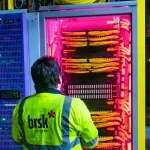EE UK Sees Positive Result from Trial of New Content Delivery Tech for TV Services

Broadband ISP and mobile operator EE has today revealed the results from last year’s trial delivery of TV content via a new Content Delivery Network (CDN) technology, which reflects BT’s effort to integrate their “world’s first” MAUD (Multicast-Assisted Unicast Delivery) solution into their CDN (originally Edgio).
Most telecoms operators use sophisticated CDNs and related systems to help manage network load, which caches popular internet content closer in the network to end-users (i.e. improves performance without adding network strain). Such systems also help to lower the provider’s impact on external links and keep bandwidth costs down.
Similarly, BT first started talking about their new IP transmission technology, called MAUD, back in December 2023 (here). Unlike traditional “unicast” delivery methods, where each broadband connected viewer watches the action via a dedicated, personal internet stream, MAUD uses “multicast” to group those single streams into one shared one, directing it to those that want to watch the action.
Advertisement
MAUD’s integration is also made completely transparent to the player application, which means content service providers (e.g. BBC, Netflix etc.) don’t need to modify their customer apps to take advantage of it (saving time and money). BT previously claimed that its MAUD technology uses up to 50% less bandwidth during peak events and reduces energy usage through the use of fewer caches, but this wasn’t put to the test until EE began their first live trial in August 2024 (here).
According to Chris Bramley, BT’s MD of NAS and Architecture (Networks), they’ve been “delighted with the results” from their first trial (blog). The test is said to have shown that, during peak times on the network, the MAUD solution converted over 60% of traffic from unicast delivery to multicast delivery.
Chris Bramley said:
“The trial used BBC Two content on EE’s set-top box TV platform in the live network – taking the technology from proof of concept to real-world. The trial has shown that during peak times on the network, the MAUD solution has converted over 60 percent of traffic from unicast delivery to multicast delivery. In simpler terms, the trial has demonstrated MAUD’s ability to flatten peaks of network traffic, by switching to multicast delivery, which is a more efficient way of delivering content over the internet.
Moving to the next stage of the trial, BT Group is looking to broaden the scope to include more channels, build out the full feature set, as well as to test the addition of dynamic ad insertion, which would enable a seamless, personalised ad experience for viewers. As seen during the recent Super-Bowl, there is high demand for ad space for live sports with CEO of Fox, Lachlan Murdoch, commenting that ‘ad space had sold out at record pricing’.
As millions look forward to watching the next live event, we’ll continue to innovate and collaborate with content and application providers, on technologies such as MAUD, to make sure that we collectively deliver the best experiences for our shared customers.”
Admittedly, from the consumer’s perspective, this is one of those seamless changes where if it’s working correctly then you probably won’t even notice it’s there. On the other hand, anything that helps to reduce network congestion is likely to result in more customers receiving higher quality streams.
Mark is a professional technology writer, IT consultant and computer engineer from Dorset (England), he also founded ISPreview in 1999 and enjoys analysing the latest telecoms and broadband developments. Find me on X (Twitter), Mastodon, Facebook, BlueSky, Threads.net and Linkedin.
« Vodafone UK and Ericsson Trial AI Tech to Improve 5G Energy Efficiency





















































Be even better if it reduces latency, streaming can still be up to a minute behind DTV or DBS transmission.
That is why it is not possible to rely on any times shown on the TV, I know they are supposed to make it so it is pretty close to real time, well they used to anyway, but it is still out. When/If Freely becomes the norm, it will be worse.
I don’t watch normal TV, but if there is a match on, and I am outside, I can hear cheers from different houses when a goal is scored, but some are slightly delayed from the others.
So with Freely, people will be cheering a minute after, maybe 🙂
The only real time thing, or as close to it as possible, is FM radio.
Can someone explain how this actually works?
If I start watching minutes after someone else do they catch the buffered stream at a different point – using the same sent data?
I always thought multicast was for live content rather than shows from providers like Netflix?
This is only for live content. I think it only works for people watching fully live too, if you press pause and then play again a bit later, say 1 minute behind live, I think you are back to watching unicast. But for football and other major live events, the majority are watching fully live, so it can save bandwidth. Live content is the biggest problem for ISPs as it causes the biggest spikes when everyone is watching at the same time, so using multicast takes the heat out the biggest spikes ISPs tend to see – and it helps the CDN with their servers too as they don’t need to be sending as many flows to their customers.
Check out the original release and video: https://newsroom.bt.com/bt-group-announces-live-tv-technology-breakthrough-to-meet-growing-customer-demand/
It was the article’s use of Netflix that threw me. That’s not been mentioned by BT. Strange to use that specific reference when there are other streamers with more live content.
So, essentially this is BT offering a B2B service to customers using a hybrid multicast service. Not focused on consumers per se, but rather on the cost of physical delivery.
And importantly, only if the live broadcaster chooses to use BT to deliver their content using their CDNs?
Edgio went bump in January…
Probably perfect for when you have two Sky Stream boxes in adjacent rooms watching the same channel with live TV. Right now that is a mess technically and from a bandwidth consumption perspective. This is will be a big improvement on getting IPTV to behave like terrestrial.
It’s not just a single household, you can imagine an entire street or district area having lots of people all streaming the footy or F1 or whatever at the same time, theoretically you don’t need to send that same data 10’s or hundreds of times over, you can do it just the once.
I don’t think so. Unless Sky is/use using BT to deliver the content, which is unlikely.
…and also not used by Freely or any other national broadcasters or ISPs.
When I first read about IPv6 SO MANY years ago, I really thought Multicast was going to be the “killer app” that would push for more adoption. It was built right into the protocol and it made so much sense back in the days when people still mainly consumed broadcast TV.
I also thought it would have been a really cool way to make BitTorrent traffic way more efficient – why send the same data over and over when you could just send it once via multicast to the entire swarm?
Alas, I was young and my naive understanding of how it worked would prove my own downfall. But still, I am surprised that in 2025 a form of multicast for live TV isn’t more prevalent, it seems like a very clean solution to a very difficult problem.
I’d wager that the bigger “spikes” in bandwidth that set new records could all be largely solved with more use of the tech. Not just live streaming, but every time Call of Duty pushes out a 100Gb+ update that millions of players abruptly download and things like that.
Can’t use multicast for downloads very readily as people will want to download at different times, different speeds and will need some data retransmitted.
Multicast is very much push it and hope for the best. Would need to build a protocol on top to fill any corrupted or missing chunks over unicast and would have to account for many different characteristics at the client side.
Streaming video like this is streaming video, some loss happens it glitches or freezes then restarts later.
Can have multiple streams as this does to account for different performance but only a limited number and not a good user experience for downloads as have to set speeds lower than maximum to account for performance.
This has been looked at in the past. So far caches as close as possible to end users have been the way to go as just too many variables to a content download.